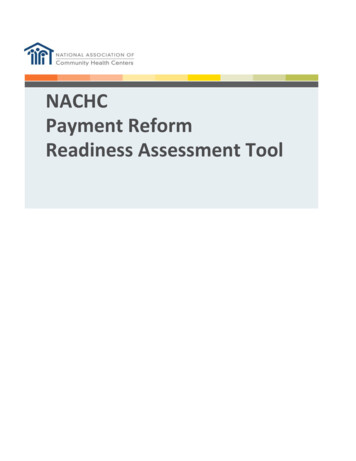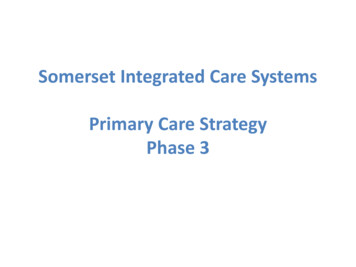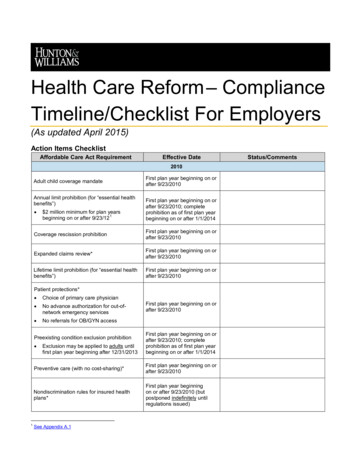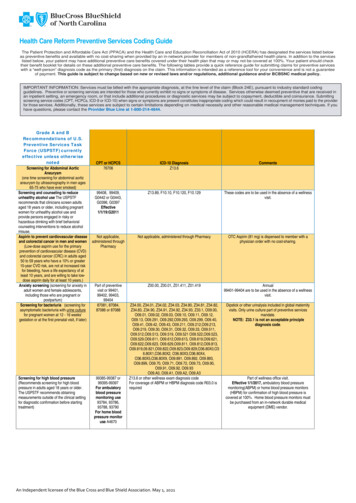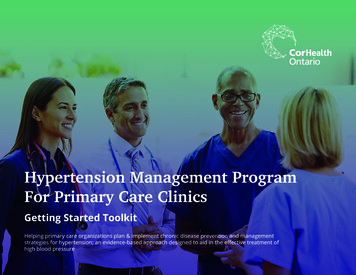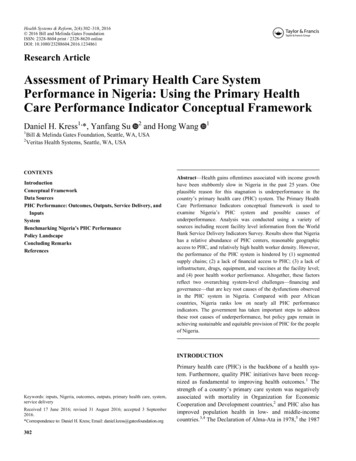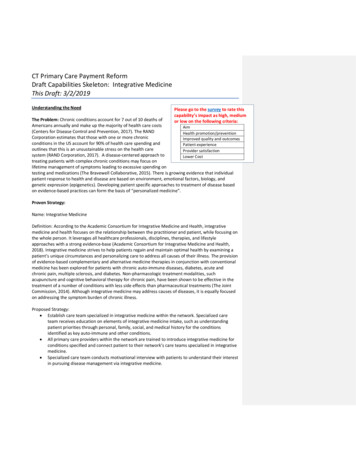
Transcription
CT Primary Care Payment ReformDraft Capabilities Skeleton: Integrative MedicineThis Draft: 3/2/2019Understanding the NeedPlease go to the survey to rate thiscapability’s impact as high, mediumor low on the following criteria:The Problem: Chronic conditions account for 7 out of 10 deaths ofAmericans annually and make up the majority of health care costsAim(Centers for Disease Control and Prevention, 2017). The RANDHealth promotion/preventionCorporation estimates that those with one or more chronicImproved quality and outcomesconditions in the US account for 90% of health care spending andPatient experienceoutlines that this is an unsustainable stress on the health careProvider satisfactionsystem (RAND Corporation, 2017). A disease-centered approach toLower Costtreating patients with complex chronic conditions may focus onlifetime management of symptoms leading to excessive spending ontesting and medications (The Bravewell Collaborative, 2015). There is growing evidence that individualpatient response to health and disease are based on environment, emotional factors, biology, andgenetic expression (epigenetics). Developing patient specific approaches to treatment of disease basedon evidence-based practices can form the basis of “personalized medicine”.Proven Strategy:Name: Integrative MedicineDefinition: According to the Academic Consortium for Integrative Medicine and Health, integrativemedicine and health focuses on the relationship between the practitioner and patient, while focusing onthe whole person. It leverages all healthcare professionals, disciplines, therapies, and lifestyleapproaches with a strong evidence-base (Academic Consortium for Integrative Medicine and Health,2018). Integrative medicine strives to help patients regain and maintain optimal health by examining apatient’s unique circumstances and personalizing care to address all causes of their illness. The provisionof evidence-based complementary and alternative medicine therapies in conjunction with conventionalmedicine has been explored for patients with chronic auto-immune diseases, diabetes, acute andchronic pain, multiple sclerosis, and diabetes. Non-pharmacologic treatment modalities, suchacupuncture and cognitive behavioral therapy for chronic pain, have been shown to be effective in thetreatment of a number of conditions with less side effects than pharmaceutical treatments (The JointCommission, 2014). Although integrative medicine may address causes of diseases, it is equally focusedon addressing the symptom burden of chronic illness.Proposed Strategy: Establish care team specialized in integrative medicine within the network. Specialized careteam receives education on elements of integrative medicine intake, such as understandingpatient priorities through personal, family, social, and medical history for the conditionsidentified as key auto-immune and other conditions. All primary care providers within the network are trained to introduce integrative medicine forconditions specified and connect patient to their network’s care teams specialized in integrativemedicine. Specialized care team conducts motivational interview with patients to understand their interestin pursuing disease management via integrative medicine.
CT Primary Care Payment ReformDraft Capabilities Skeleton: Integrative Medicine This Draft: 2/25/2018Specialized care team provides patient education on how to change lifestyle and participate inintegrative medicine treatments for the specified conditions.Specialized care team refers patients to integrative medicine providers and tracks outcomes.Intended Outcomes: Address the symptom burden of acute or chronic illness (i.e., secondary and tertiary prevention) May also examine the causes of symptoms or conditions Reduce unnecessary and expensive treatment of disease symptoms Distribute physician workload on a care team of practitioners with differing backgroundsConsumer Needs: Medication and supplies to manage disease are too costly and can have significant sideeffects Hard to find resources for lifestyle changes Need for improved communication and listening between patients and care teams Need for support services from a care team beyond conventional medical careHealth Equity Lens: Inclusion of integrative medicine in a primary care model would offer the patient-centeredapproach to a wider patient group Treatment of causes has the potential to reduce cost burden of expensive symptommanagement as well as to reduce symptoms of chronic disease Conditions such as chronic lower back pain disproportionately impact racially andeconomically diverse communities for which integrative therapies make an impactImplementing the StrategyExample Scenario: A patient with multiple sclerosis visits their primary care provider due to recentincreased fatigue and numbness. The primary care provider discusses how to manage the patient’ssymptoms and informs the patient about their network’s integrative medicine care team, including anacupuncturist. The network’s care team works with the patient to understand the patient’swillingness to participate in alternative therapies, the acupuncturist conducts a session with thepatient, and recommends a follow-up visit to assess the session’s impact.HIT Requirements: Standardized EHR platform to share information within the care team and perform standardizedintegrative medicine intake Secure electronic platform for multiparty consultation and continuous patient-care teamcommunication to monitor symptom management and root cause impact Education platform for care teams, primary care providers, and patients to understand how toincorporate integrative medicine into practiceImplementation Concerns: Need for standardization in the measurement of integrative medicine treatments for thespecified conditions to determine impact of network care teams Unclear understanding of integrative medicine among providersPage 2 of 6
CT Primary Care Payment ReformDraft Capabilities Skeleton: Integrative Medicine This Draft: 2/25/2018Insurance does not typically cover integrative medicine services for patientsImpactAimSummary of EvidenceHealth promotion/prevention Integrative and preventive medicine overlap in approaches toprimary, secondary, and tertiary prevention. They stress lifestylecounseling, dietary guidance, stress mitigation techniques,interventions to improve sleep quality, and use of naturalproducts for primary prevention. Stress management andlifestyle interventions and use of conventional therapies arerelied on for secondary prevention. Tertiary prevention includescomplementary health approaches for pain management,symptom control, stress relief, disease management, and riskreduction (Ali & Katz, 2015). There is not yet evidence that theseapproaches improve health promotion and primary prevention,further studies evaluating impact are needed.Improved quality and outcomes Patients with breast/gynecological cancer undergoingchemotherapy and with gastro-intestinal symptoms whoattended 4 or more integrative medicine treatments in six weekshad significantly improved European Organization for Researchand Treatment of Cancer Quality of Life Questionnaire scores forappetite, fatigue, cognitive functioning, and emotional functionas compared to the control group (Shalom-Sharabi et al., 2017).The intervention group also scored better on the EdmontonSymptom Assessment Scale for pain, anxiety, and sleepcompared to the control group.Patient experience Patients at the integrative medicine adult primary care clinic atthe University of Arizona Integrative Health Center rated theirexperience with the practice through surveys based on CAHPSand CARE measures (Crocker et al., 2017). The practice receivedhigh scores on whole person care (knowledge of medical history,values about health, worries and stress, and patientresponsibilities), promotion of health (interventions to improvehealth, lifestyle changes, emotional well-being, etc.),relationships and communication (treating patients with respect,spending enough time with the patient, trust), access to care(receiving an appointment in 5 of fewer days), and overallsatisfaction.Provider satisfaction According to a study of over 1,000 integrative medicine doctorsand doctors of osteopathy, 67% of doctors surveyed reportedquality of life as “much better” or somewhat better” ascompared to their practice of medicine prior to inclusion ofintegrative medicine techniques (Fierce Healthcare, 2017). Thedoctors reported feeling less burnt out due to being able tospend more time with patients.Page 3 of 6
CT Primary Care Payment ReformDraft Capabilities Skeleton: Integrative MedicineThis Draft: 2/25/2018Lower Cost For lower back pain, non-surgical procedures, such aschiropractic treatments, have shown to provide similar outcomesat a significantly reduced cost when compared to surgicalprocedures (Spero, 2017). Additional research on cost savingsfrom integrative medicine therapies is needed. Integrativemedicine avoids expensive diagnostic testing, which may occur inconventional medicine or functional medicine.**Please complete the survey on this capability here.APPENDIXLearning from OthersState and National Scan:Case Study #1 Saint Francis Hospital and Medical Center of Connecticut has found value in integrativemedicine referrals and development of a cadre of integrative medicine professionals. The hospital hasprovided educational assistance to link a family medicine practitioner to a two-year fellowship inintegrative medicine at the University of Arizona. The family physician trained in integrative medicineprovides consultations to primary care and specialty teams to provide referrals to integrative medicineresources, such as acupuncture, massage and relaxation therapies, yoga classes, and nutritionalassistance.Lessons Learned: Acupuncture has provided relief to patients with depression, anxiety and fatigue due to cancertreatment, and pain due to gastro-intestinal issues Billing for integrative medicine services and professionals through traditional health insurance istime consuming and claims may be denied Reimbursement for the primary care provider is more consistent than for the rest of the careteamCase Study #2 The National Center for Integrative Primary Healthcare, founded by the AcademicConsortium for Integrative Medicine and Health and the University of Arizona Center for IntegrativeMedicine, has worked to develop a set of core competencies for primary care teams with integrativemedicine training (National Center for Integrative Primary Healthcare, 2016). Based on thesecompetencies the group has developed a 45-hour interprofessional online training for primary careteams. Their work has focused on developing educational resources for primary care teams to shareintegrative medicine information and best practices, linking primary care teams to integrative healthresources, and developing a patient portal. The NCIPH will continue to further access to integrativemedicine in primary care through development of patient education materials on integrative medicinebenefits.Additional Reading:Page 4 of 6Commented [SHAP1]: As to cost, we need to understandthe % of cost add-ons likely incorporating Integrative /CAMmedicine. There should be data out there.
CT Primary Care Payment ReformDraft Capabilities Skeleton: Integrative MedicineThis Draft: 2/25/2018A list of resources such as publications in peer-reviewed journals and articles from respected trade andpopular press.Academic Consortium for Integrative Medicine. (2018). Retrieved i A, Katz DL. (2015, November). Disease Prevention and Health Promotion. Retrieved from AmericanJournal of Preventive Medicine: 0408-0/fulltextCrocker, R. L., Grizzle, A. J., Hurwitz, J. T., Rehfeld, R. A., Abraham, I., Horwitz, R., . . . Maizes, V. (2017).Integrative medicine primary care: Assessing the practice model through patients’ experiences. BMCComplementary and Alternative Medicine,17(1). doi:10.1186/s12906-017-1996-5Droz N, Messner W, Husni ME. What Is the Impact of Functional Medicine on Patient ReportedOutcomes in Inflammatory Arthritis? [abstract]. Arthritis Rheumatol. 2017; 69 (suppl utcomes-in-inflammatory-arthritis/.Integrative and Functional Medicine Main Line Health Philadelphia, Pennsylvania. (2018). Retrievedfrom tive-and-functional-medicineIrving, D. (2017, July 12). Chronic Conditions in America: Price and Prevalence. Retrieved htmlMinemyer, P., Finnegan, J., & Finnegan, J. (2017, August 22). Integrative medicine physicians say qualityof life is better. Retrieved from etterNational Center for Chronic Disease Prevention and Health Promotion (NCCDPHP). (2017, June 27).Retrieved from cations/aag/NCCDPHP.htmNational Center for Integrative Primary Healthcare. (2016). Retrieved from https://nciph.org/Shalom-Sharabi, I., Samuels, N., Lavie, O., Lev, E., Keinan-Boker, L., Schiff, E., & Ben-Arye, E. (2017, July).Effect of a patient-tailored integrative medicine program on gastro-intestinal concerns and quality of lifein patients with breast and gynecologic cancer. Retrieved ero, J. (2016, July 18). Integrative Medicine – A Powerful Tool for Employee Healthcare CostContainment. Retrieved from ntainment/The Joint Commission. (2014, November 12). Revisions to pain management standard effective January1, 2015. Retrieved from ne November 12 14.pdfPage 5 of 6
CT Primary Care Payment ReformDraft Capabilities Skeleton: Integrative MedicineThis Draft: 2/25/2018Weisfeld, V. (2009). Summit on Integrative Medicine & The Health of the Public: Issue Background andOverview. Washington, DC: Institute of Medicine. Retrieved fromhttp://www.bravewell.org/integrative medicine/Page 6 of 6
Mar 05, 2019 · CT Primary Care Payment Reform Draft Capabilities Skeleton: Integrative Medicine This Draft: 3/2/2019 Understanding the Need The Problem: Chronic conditions account for 7 out of 10 deaths of America
